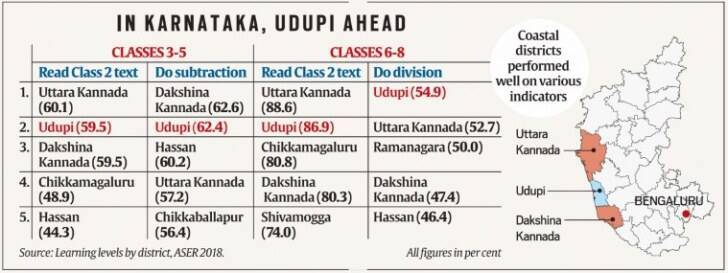Udupi: education
This is a collection of articles archived for the excellence of their content. Additional information may please be sent as messages to the Facebook community, Indpaedia.com. All information used will be gratefully acknowledged in your name.
This is a collection of articles archived for the excellence of their content. |
History
1890-2022
Uma Vishnu, March 17, 2022: The Indian Express

From: Uma Vishnu, March 17, 2022: The Indian Express
Missionaries, banks, individuals: behind Udupi’s tradition of education
The region — Udupi was carved out of Dakshina Kannada (South Canara) as a separate district in 1997 — was part of the Madras Presidency of the Raj. The foundations of education in the region were laid by Christian missionaries. This gave coastal Karnataka a head start compared to other regions of the state.
Udupi in coastal Karnataka, the theatre of the hijab controversy, is among the state’s best performing districts, which has traditionally scored high on learning indicators. The verdict of the Karnataka High Court on Tuesday upholding the government’s restriction on Muslim women wearing hijab in educational institutions has raised concern over the potential impact on students who may now be forced to make a choice between their faith and their studies.
The adjoining districts of Udupi and Dakshina Kannada in coastal Karnataka are home to many educational institutions — from the 183-year-old Basel Evangelical Mission School in Mangaluru and Manipal where one of India’s first private universities came up, to the dozens of newer schools and colleges that were established to cater to the ever-growing demand for English education.
Learning surveys such as the Annual Status of Education Report (ASER), and studies including an analysis of the 64th and 75th rounds of the National Sample Survey (NSS) by Khalid Khan of the Indian Institute of Dalit Studies, have shown a steady uptick in the gross attendance ratio of Muslim women in higher education in these two districts.
ASER 2018 (pre-pandemic) data showed 86.9% of Class 6-8 children in Udupi and 80.3% in Dakshina Kannada could read a Class 2 textbook. They were behind only Uttara Kannada, the other district in coastal Karnataka (88.6%). For perspective, the average for the state was only 62%.
Children in ASER’s Mysore division — the eight districts of which include Udupi and Dakshina Kannada — have significantly better reading and math skills than children in the other three divisions of Bangalore, Belgaum, and Kalaburagi.
Students from Udupi and Dakshina Kannada have consistently made it to the Top 5 of the Pre-University College (PUC, Class 12) rankings. In 2020-21, students from Udupi topped the PUC ranking for the third straight year, while students from Dakshina Kannada stood second. In 2021, Dakshina Kannada district had a PUC pass percentage of 90.70%, the highest in Karnataka, followed closely by Udupi at 90.01%.
According to the National Family Health Survey-5 (2019-20), preschool attendance in Karnataka was the highest in Udupi at 56.3%; the state average was 40%.
The region — Udupi was carved out of Dakshina Kannada (South Canara) as a separate district in 1997 — was part of the Madras Presidency of the Raj. The foundations of education in the region were laid by Christian missionaries, who established schools and teacher training institutes, including St Ann’s Training College in Mangaluru in 1890, among the earliest institutions of its kind in India. This gave coastal Karnataka a head start compared to other regions of the state, especially Hyderabad-Karnataka to the north, which was under the Nizam’s rule.
In the years after Independence, several committed educationists built on this legacy, including the legendary TMA Pai who set up the Manipal group of educational institutions, starting with a primary school before building a number of degree colleges (including Mahatma Gandhi Memorial College that saw protests over hijab), and medical and engineering colleges.
In the 1970s, there were Nitte Vinaya Hegde of the Nitte (deemed-to-be) University, and Yenepoya Abdulla Kunhi, who started the Islamic Academy of Education Trust that runs a number of medical, dental, and nursing colleges, besides a deemed-to-be university in Udupi. The region is also home to the Pejawar and Adamaru mutts, among the eight monasteries associated with the Udupi Sri Krishna Mutt, which too played a part in promoting education by setting up schools.
At the heart of the region’s educational success is private enterprise. “People of this region did not completely rely on the government because they thought community participation was essential in promoting education… The pioneer was Dr TMA Pai, who established about 34 educational institutions. The district (Udupi) does not have a single government medical or engineering college,” said Kannada writer Mahabaleshwar Rao, who retired as principal of TMA Pai College of Education.
The region’s strength in education also derived from its tradition of banking, Rao said. Syndicate Bank, Canara Bank and Corporation Bank were born here. “These banks hired people who had passed SSLC (Class 10). Girls got bank jobs and became financially independent. As families came to have a financial cushion, they were able to spend more on their children’s education,” he said.
Ashok Kamat, vice principal, DIET (District Institute of Education and Training), Udupi, said the Hunter Commission’s (1882) concept of aided schools, which missionary organisations used effectively, gave a fillip to education in the region.
“Under the British government’s policy, if you studied up to Class 8, you could become a teacher. So even people from low-income groups qualified. Almost every house here has a teacher,” Kamat said. He also credited men like Panje Mangesh Rao, a 19th century poet and education officer who developed textbooks in Kannada and worked to make education more accessible to the people.